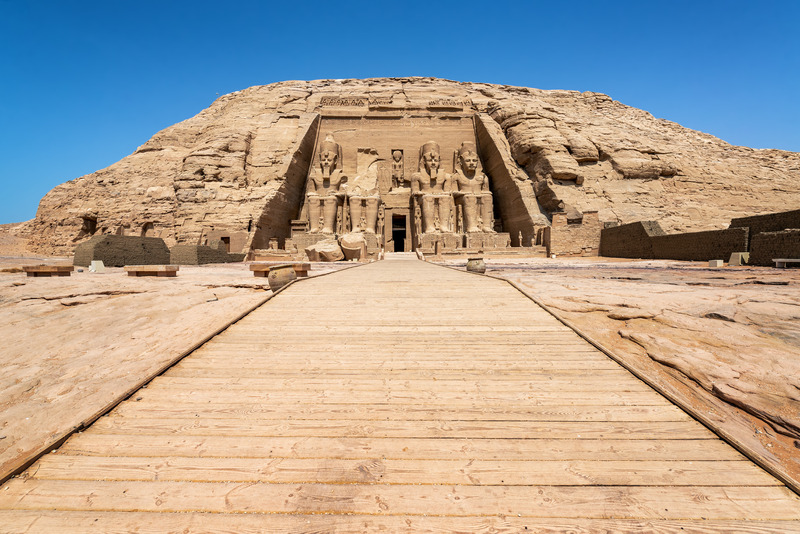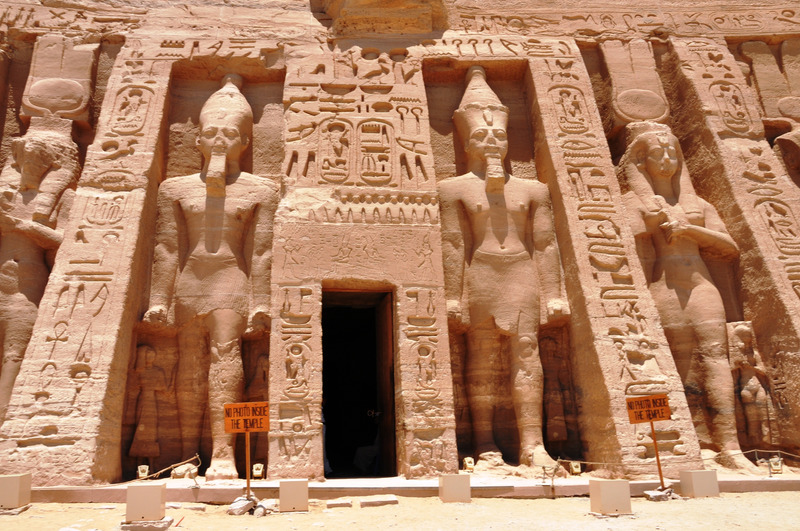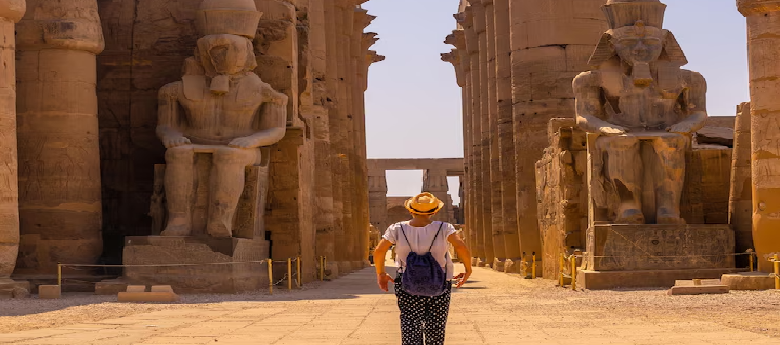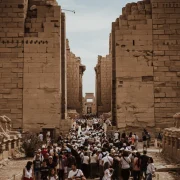
Tour luxor abu simbel : 7 Reasons This Journey Will Amaze You
Tour Luxor Abu Simbel is an experience that will be etched in your memory forever. You’ll delve into history, dating back 3,000 years, to discover for yourself a legend carved in the rock that tells chapters from ancient Egypt to the Abu Simbel Temple, located on the shores of Lake Nasser, in the far south of Egypt. It remains a testament to the genius of King Ramses II and his ability to immortalize his victories and the secrets of his civilization in stone tablets whose brilliance has not faded to this day.
Tour Luxor Abu Simbel takes you into a world of amazement. Its facade is adorned with four giant statues of Ramses II, guarding the entrance to the temple as if gazing across the ages. Inside, you’ll find inscriptions and decorations that tell stories of battles and sacred rituals, making the visitor feel as if they are walking between the pages of an open history book, written in the language of stone and light.
Table of Contents
ToggleTour luxor abu simbel introduces you to the greatest achievements of King Ramses II:

Tour luxor abu simbel explores one of King Ramses II‘s greatest achievements in the New Kingdom. Its construction dates back to the 13th century BC, during the 19th Dynasty. It was carved entirely from the rock on the west bank of the Nile, near the Egyptian-Sudanese border, to commemorate the king’s victories, particularly at the Battle of Kadesh, and to demonstrate Egypt’s prestige in the south.
The inscriptions on its walls reveal that the temple was also a political and diplomatic means of imposing Egyptian influence over Nubia. It was dedicated to the worship of the gods Ra-Horakhty, Amun, and Ptah, in addition to the deification of King Ramses himself as a living god. The imposing facade, with four colossal statues of the king, nearly 20 meters high, served as a message of strength to all who passed through the area.
The Secret of the Sun’s Perpendicularity Phenomenon:
What adds to the place’s magic is the unique astronomical phenomenon of the sun’s perpendicularity, which occurs twice a year, illuminating the face of the king inside the Holy of Holies, as if the pharaohs still control the universe. Tour luxor abu simbel is not just a visit; it is a spiritual and cultural experience that will be etched in one’s memory forever.
Twice a year, on February 22 and October 22, the sun falls directly on the face of the statue of Ramses II inside the Holy of Holies, reflecting the ancient Egyptians’ mastery of astronomy and engineering. This phenomenon served as an annual celebration that attracts visitors from around the world to this day.
Queen Nefertari’s Status with Her Husband:
King Ramesses II demonstrated his appreciation for his wife, Queen Nefertari, by building a smaller temple next to his great temple. Within its corridors, inscriptions tell you that the temple was dedicated to the worship of the goddess Hathor. During your Tour luxor abu simbel, you will discover that Nefertari’s temple is one of the most beautiful ancient Egyptian temples, distinguished by its delicate carvings depicting the queen in a position equal to the king, a rare sight in ancient Egyptian art.
Your Tour luxor abu simbel will captivate your senses as soon as you stand at the facade of the Great Temple at Abu Simbel. It is one of the most magnificent architectural masterpieces in ancient Egypt. The view is dominated by four colossal statues of King Ramesses II, each approximately 20 meters tall, carved directly into the rock.
These statues stand in a majestic row, inspiring admiration and awe in the hearts of visitors, as if they were guardians of time, silently telling the story of a king who ruled with great power and might. The facade was designed to face the sunrise, providing it with magical natural light in the early morning.
Why is Abu Simbel considered a masterpiece that commemorates the ancient Egyptians’ engineering prowess?

Tour luxor abu simbel will dazzle you with its fine details as soon as you approach the facade. You’ll witness the precision of the confident facial features, the decorations, and the carved inscriptions around the entrance. Between the legs of the giant statues are smaller statues of members of the royal family, a symbolic reference to their distinguished status, despite their small size compared to the majesty of the king. This harmony between massive size and meticulous detail makes the facade of the Abu Simbel Temple a masterpiece that commemorates the ancient Egyptians’ skill in sculpture and engineering.
Tour luxor abu simbel will take you on a journey through time, beginning with the massive hypostyle hall, which features eight statues of Ramses II, standing in two rows on either side of the main passageway, forming a majestic corridor leading into the depths of the temple. The rooms and halls are arranged in a precise geometric pattern, culminating in the Holy of Holies, which houses four statues of the temple’s deities and King Ramses II. Twice a year, the sun’s rays illuminate their faces. This architectural arrangement was not random; rather, it was carefully designed to align with the religious and astronomical beliefs of the ancient Egyptians.
Tour Luxor Abu Simbel reveals the true essence of the interior inscriptions of the Abu Simbel Temple, which are like an open book recounting the heroic deeds of Ramses II and the glories of Egypt, particularly the famous Battle of Kadesh. The war scenes are depicted with artistic precision, reflecting the strength and organization of the Egyptian army. You will also witness ritual and religious inscriptions depicting the king offering sacrifices to the gods, reflecting the temple’s role as a place of worship and politics simultaneously.
In what sciences did the ancient Egyptians demonstrate their superiority when building the Abu Simbel Temple?

The Abu Simbel Temple is a living testament to the ancient Egyptians’ progress in astronomy and engineering. You will discover this during Tour luxor abu simbel, especially as you stand before the temple’s design, which takes into account the connection between the architectural design and the sunlight falling on the faces of the statues in the Holy of Holies twice a year. This reveals that the temple design and architectural art that the ancient Egyptians created were not merely decorative, but were closely linked to astronomy.
Temple of Nefertari:
Tour luxor abu simbel is an opportunity to learn about the details of the Temple of Nefertari, or the Small Temple, which stands next to the Great Temple of Abu Simbel as a unique architectural masterpiece dedicated to Queen Nefertari, wife of King Ramses II, and to the goddess Hathor. Despite its smaller size compared to the Great Temple, its design combines delicacy, artistic beauty, and architectural precision.
The facade of the Temple of Nefertari is decorated with six towering statues, three of which are of Ramses II and three others.
A rare occurrence in ancient Egyptian architecture, the queen was given equal status to the king in stone representation. Each statue is approximately 10 meters high, reflecting Ramesses’s appreciation for his wife and her special status.
As you enter the temple during the Tour luxor abu simbel, you will find a hall supported by six columns, their heads crowned with crowns in the form of the face of the goddess Hathor, a symbol of love, beauty, and music. The walls are decorated with magnificent reliefs depicting the queen offering sacrifices to the gods, along with scenes of Ramesses in religious and military settings. At the end of the temple is the Holy of Holies, which contains a statue of the goddess Hathor in the form of a cow, protecting the queen in her lap, a symbolic representation that combines strength, protection, and beauty.
Explore the dazzling details of Tour luxor abu simbel. The Great Temple was designed so that the sun’s rays penetrate the Holy of Holies twice a year, illuminating the faces of three of the four seated statues inside: the god Ra-Horakhty, the god Amun-Ra, and King Ramesses II. The face of Ptah, the god of darkness, remains in shadow, as intended. This amazing phenomenon underscores the meticulous precision with which ancient architects determined the temple’s angles and orientation relative to the sun’s path.
You can take Tour luxor abu simbel in February and October. The phenomenon occurs on two specific dates each year: February 22, believed to mark the anniversary of King Ramesses II’s accession to the throne, and October 22, believed to be his birthday. On these two days before sunrise, you can enjoy the majestic sight as the dawn rays penetrate the stone passages and illuminate the Holy of Holies in a silent and solemn moment, as if the pharaohs had prepared an eternal solar show that would span the ages.
Why is the sun perpendicular to the Temple of Abu Simbel?
Egypt Travel, the company that organizes Tour luxor abu simbel, confirms that the reason for the phenomenon of the sun’s perpendicularity at the Temple of Abu Simbel is due to the precise architectural planning adopted by the ancient Egyptians. The temple was built according to a specific astronomical alignment that allowed the sun’s rays to penetrate its passageways on certain days of the year.
The architects carefully chose the direction of the temple and the angle of its entrance so that the moment the sun’s rays entered the Holy of Holies coincided with two important occasions in the life of King Ramses II: his birthday and his coronation. This links the temple’s design to important political and personal events in the ruler’s life.
How to get to Abu Simbel?
Egypt Travel organizes a Tour luxor abu simbel to ensure your comfort, especially since the distance between Aswan and the Abu Simbel Temple is long, about 280 kilometers south of Aswan, near the Egyptian-Sudanese border. The journey takes you along a long desert road that runs alongside Lake Nasser, making reaching the temple a special experience. During your visit, you’ll witness serene landscapes and vast desert landscapes, adorned in some areas by the blue waters of the lake.
You can take a plane to reach Abu Simbel Temple, which takes only about 45 minutes. Direct flights are available daily to Abu Simbel Airport, which is just minutes away from the temple. This makes choosing a plane an ideal option to avoid long travel times.
If you want to enjoy the views along the road during your visit to Abu Simbel Temple during a Tour luxor abu simbel, you can take a bus or car. You can enjoy a wonderful road trip from Aswan to Abu Simbel, which takes about 3 to 4 hours. This option is popular because it’s cheaper than flying and gives visitors the opportunity to see the desert road that runs along Lake Nasser.
Egypt Travel organizes a tour to Luxor and Abu Simbel, whether by plane or bus. The trip to Abu Simbel Temple includes round-trip transportation, temple entrance fees, and tour guide services. The tour starts in the early hours of dawn if traveling by land, or shortly after sunrise if flying. This allows you to enjoy a relaxing tour and return to Aswan the same day.
What is the best time to take a tour to Luxor and Abu Simbel?
Egypt Travel advises its existing and new clients that the best time to take a tour to Luxor and Abu Simbel is during the winter, from October to April. The weather is moderate, making it ideal for exploring the temples and archaeological sites without being exposed to the intense summer heat. Temperatures during this period are pleasant, making for a comfortable visit, whether in the morning or during day trips.
The peak tourist season in Abu Simbel is during the months of December, January, and February, when tourists from all over the world flock to enjoy the temples, especially during the solar alignment on February 22 and October 22. The temple attracts large numbers of visitors to witness this unique astronomical phenomenon, making it one of the most important tourist seasons in Aswan and southern Egypt.
Important Tips During Your Tour luxor abu simbel:
When taking your Tour luxor abu simbel, Egypt Travel advises its clients to prepare well for the trip, as the site is located in a hot desert area most of the year. It’s essential to bring a sufficient bottle of water to stay hydrated, along with a hat or small umbrella to protect from the strong sun. Carrying a camera is also essential to capture special moments and document the splendor of the Pharaonic carvings and sculptures that adorn the temple walls.
Regarding photography during your Tour luxor abu simbel, there are rules that must be followed. Regular photography is permitted without a flash, as using a flash may damage the ancient carvings and colors. At times, the temple administration may charge additional fees for professional camera or video photography. It is always advisable to inquire with the officials at the entrance and adhere to the rules to preserve the monuments and ensure an enjoyable experience for everyone.
Recent Posts
East Bank Luxor Tour: 5 Unmissable Highlights to Explore
Tour luxor abu simbel : 7 Reasons This Journey Will Amaze You
Luxor Aswan Tour: Top 10 Temples and Tombs to Explore
All Categories

Luxor




